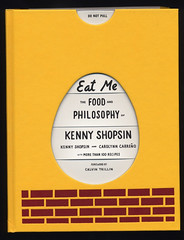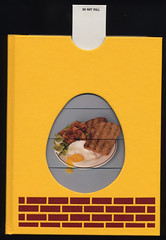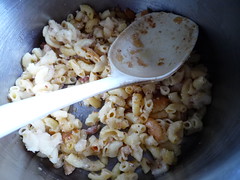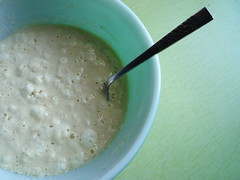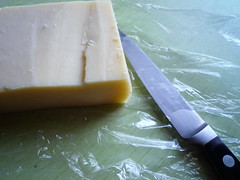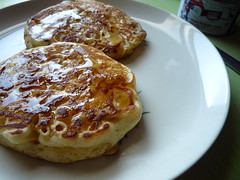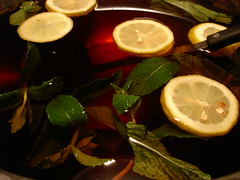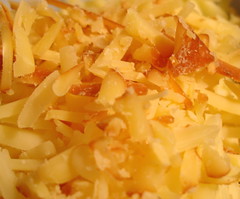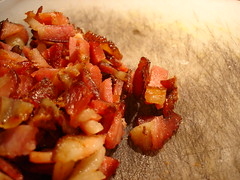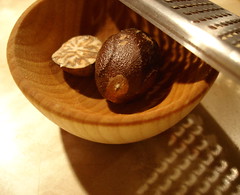Holiday High Jinks
Another year, another holiday special. Except that this one was a little extra-special. We weren't able to celebrate AEB's 5th anniversary in November when that momentous date passed on by, so our 5th annual holiday jam* doubled as our AEB 5th Anniversary Party.
Last year, our party's centerpiece was a ham twin-set--one Kentucky country ham served raw in thin slices, and one Virginia country ham that had been baked. This year we featured another country ham--this time from William Mulder's Fresh Meats of Fredericton, NB--but, frankly, the savory fare got overshadowed a bit by our first annual AEB gingerbread house.
I can honestly say that I had nothing to do with the gingerbread house, aside from a little consulting. The gingerbread house was the product of the Montreal Cake Club (M.C.C.), a local cell of cake-decorating extremists with reputed links to Laloux, the Preservation Society, and La Salle à manger. It didn't weigh 390 pounds, and it wasn't covered in white chocolate, but, like the 2009 White House Gingerbread House, it was modeled on an actual existing structure: the M.H. Merchant Stone House.
 fig. a: M.H. Merchant Stone House
fig. a: M.H. Merchant Stone House
The finished product looked something like this,
 fig. b: M.H. Merchant Gingerbread House 1
fig. b: M.H. Merchant Gingerbread House 1
 fig. c: M.H. Merchant Gingerbread House 2
fig. c: M.H. Merchant Gingerbread House 2
and by the morning after, it was a little worse for wear (note the candied-almond "stones" missing from the walkway),
 fig. d: M.H. Merchant Gingerbread House 3
fig. d: M.H. Merchant Gingerbread House 3
but it was still pretty magical. In fact, if you took a close look and peered through the caramel "glass" windows, you'd swear there was someone inside taking advantage of the spacious two-story, 4 1/2-room interior.
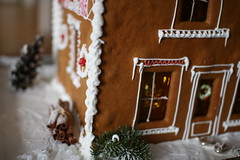 fig. e: M.H. Merchant Gingerbread House 4
fig. e: M.H. Merchant Gingerbread House 4
Anyway, the M.C.C.'s M.H. Merchant Gingerbread House was certainly an impressive sight, and it was 100% edible, but it wasn't really meant to be eaten (that didn't stop some of our guests from trying, though). Attending to the more immediate spiritual needs of our invited guests was the following vaguely Mad Men-inspired menu:
Coca-Cola- & Chipotle-Glazed Ham
Serious Mac & Cheese, Smothered w/ Cajun Gravy
Chicken & Sausage Gumbo
Cajun Deviled Eggs
Crudités
Crackers
Cucumber-Herb Dip
Baked Artichoke Dip
Clam Dip
Cheddar Cheese
Armadale Farm Cumin Gouda
Heineken
Punchbowl Old-Fashioneds
Martinican Rum Punch
Bourbon Chocolate Cookies
Vanilla Crescents
fresh clementines
We were dead-set on another baked ham. Ham has become something of a tradition at our holiday parties, and we'd managed to source a particularly good smoked ham in the Maritimes. Then we received our December issue of Saveur--"HAM FOR THE HOLIDAYS"--and it was as if the food gods (or at least the food press gods) were speaking directly to us (and about 600,000 others). Their cover story has plenty of great-looking ham-centric recipes, but the one that really caught our attention was the Pineapple-Chipotle-Glazed Ham (who knows, might have had something to do with the fact that that's the one featured on the cover). We'd always wanted to do a Coca-Cola ham, but this recipe's Coke, chipotle, and honey glaze sounded particularly tempting.
Coca-Cola- & Chipotle-Glazed Ham
1 15-lb whole smoked ham
8 fresh pineapple slices
whole cloves
2 3/4 cups Coca-Cola
1 rounded tbsp chipotle purée
1/3 cup honey
Put the ham into a large stockpot, cover with water, and bring to a boil. Reduce heat and simmer for 60 minutes.
Heat oven to 350º. Transfer the ham to a roasting rack in a roasting pan. Using toothpicks, secure the pineapple slices to the surface of the ham. Stud the ham with cloves to taste [Saveur recommends 64 cloves, but we like our ham a little less clove-y, so we went with about half that many]. Pour 2 cups of the Coca-Cola over the ham, then add 1 cup of water to the bottom of the roasting pan. Cover loosely with foil and bake for 60 minutes.
Meanwhile, combine the remaining Coca-Cola, the chipotle purée, and the honey in a saucepan and bring to a boil. Reduce the heat to medium, and cook, stirring frequently, until the glaze has reduced and become syrupy, roughly 12-15 minutes. Uncover the ham and brush it with some of the glaze. Increase the heat of the oven to 500º. Bake the ham, brushing occasionally with the glaze, until it has become browned and glossy, about 15-20 minutes. [Make sure to watch the ham carefully, though. If it starts to brown too quickly, you may want to protect it with that loose foil covering again.] Let cool for 20 minutes before carving.
As for the mac & cheese. This recipe was quite literally the product of hearsay. As in, a couple of weeks ago, I was motoring along on the Trans-Canada, listening to a podcast of American Public Media's The Splendid Table, when I heard Jane & Michael Stern gushing about Rocky & Carlo's in Chalmette, Louisiana. The segment was about the famed hybridity of Louisiana's cuisines, and the ways in which the Italian-American idiom has coupled with Cajun, Creole, and Southern cuisine in all kinds of interesting ways there, but mostly it was about Rocky & Carlo's as a prime example of this culinary bricolage. There was a lot about the Sterns' spiel that had me ready to veer off my easterly course and make a beeline for Chalmette, but the thing that stuck with me the most was their positively ecstatic descriptions of Rocky & Carlo's macaroni & cheese. They came out and anointed Rocky & Carlo's mac & cheese their very favorite mac & cheese in all of America (!). They had plenty of good reasons for naming Rocky & Carlo's mac & cheese #1, but a big part of its considerable charm had to do with the fact that you could get it smothered with either a red sauce or a Cajun brown sauce. For a split second there, I seriously thought about putting the pedal to the metal over the border and across 8 eight states all the way to Chalmette to give that smothered mac & cheese a try, but then I came up with a Plan B: put the pedal to the metal all the way to my kitchen so that I could improvise a batch of Mac & Cheese Smothered w/ Cajun Brown Sauce myself.
The following is what I came up with. Does it bear any resemblance to Rocky & Carlo's? I have no idea, but mac & cheese has rarely tasted so good.
Smothered Mac & Cheese
Make your preferred macaroni & cheese recipe, keeping in mind that you're going to smother it with a zesty roux-based brown sauce momentarily, so you might want to keep things simple and straightforward, and you might want to avoid a béchamel sauce and go with a cheese and milk/cream sauce instead (the logic: béchamel + roux + macaroni = flour + flour + flour).
Got your macaroni & cheese in the oven? Perfect. Now it's time to make your brown sauce:
1/4 cup vegetable oil
1/4 cup all-purpose flour
1/2 small onion, diced
1/2 celery stalk, diced
1/4 bell pepper (green or red), diced
2 tbsp mixed herbs (parsley, thyme, chives, etc.), finely minced
1 tbsp Cajun Magic (recipe follows)
2 cups vegetable or chicken stock (or 2 cups water, in a pinch) [we've been using vegetable stock and/or water, usually, meaning our smothered mac & cheese has been 100% vegetarian!]
salt & pepper to taste
Warm your stock in a separate saucepan.
Heat the oil over medium heat in a large non-stick frying pan or a properly seasoned skillet. When the oil is hot, add the flour all at once and begin stirring constantly. Make a deep Cajun roux. When your roux has reached your desired depth (I recommend going with a cappuccino-colored roux here), add the onion and sauté for 2-3 minutes. Add the celery and bell pepper and sauté for another 2-3 minutes. Add the herbs, stir, and add the Cajun Magic, sautéing for another minute. Add the stock in a slow stream, stirring constantly. Cook the gravy until it thickens, reaching your desired consistency. If it thickens too quickly and you want the flavors to meld a bit longer, add a bit more water or stock and cook it down some more over medium heat. Add salt and pepper to taste.
Serve your hot macaroni and cheese, smothering each helping with plenty of the brown sauce, and topping with a dash or two of Tabasco sauce, if you so desire.
Cajun Magic
1/4 Cup of salt
2 tbsp sweet paprika
2 tbsp cayenne pepper, espelette pepper, or hot paprika
1 tbsp onion powder
1 tbsp garlic powder
1 tbsp black peppercorns
1 tbsp white peppercorns
2 tsp dried basil
1 tsp chili powder
1/2 tsp dried thyme
Combine all the ingredients, and, using a mortar & pestle or an electric spice grinder, grind them together. The resultant spice blend should be lively and complex.
We knew we were making Martinican Rum Punch again this year--we've been rockin' that recipe for several years now, and it's a guaranteed crowd-pleaser. But this year we wanted to add a new drink to our arsenal of beverages. We thought about making Old-fashioneds to order, but then discovered this ingenious punchbowl version in the Esquire Party Book. Much, much easier to prepare, and our guests loved 'em. Maybe a little too much. They cleaned us out of the first batch in no seconds flat, and, the next thing we knew, a chant of "Make more punch! Make more punch!!" erupted throughout the apartment. You've been warned.
Punchbowl Old-fashioneds
8 lumps of sugar
2 tbsp bitters
1/3 cracked ice or 1 appropriately sized ice ring
1 quart bourbon or rye
16 slices of orange, lemon
16 cherries
Muddle the sugar, bitters, and ice together in a punch bowl. Add the bourbon or rye and stir well. Drink responsibly-ish.
How good were these Punchbowl Old-fashioneds? This good:
 fig. f: Michelle loves Old-fashioneds
fig. f: Michelle loves Old-fashionedsThanks to all our guests for making our 5th anniversary bonanza such a blast and for participating so generously in our donations drive for Dans la rue.
 fig. g: in the light of the miracle
fig. g: in the light of the miracleThanks to MS and CWI for packing pixels and helping us to document the festivities.
aj
* If you're particularly devoted to reading AEB and particularly good at math, you might be thinking: "seeing as you threw your first AEB holiday party just weeks after you started the blog, shouldn't this be your 6th holiday party?" And you'd be right. It should have been our 6th, but, if you must know, we skipped a year once.
